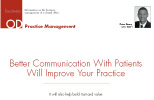Better Communication With Patients Will Improve Your Practice
 Originally Published in Ontario Dentistry Journal
Originally Published in Ontario Dentistry Journal
written by Peter Barry
Why Is Communication So Important?
That is the question every dentist needs to understand in order to become more effective at inspiring people and achieving professional and overall success. In his acclaimed best-selling book, Start With Why: How Great Leaders Inspire Everyone to Take Action, Simon Sinek, ethnographer and author, notes that most people or organizations can explain “what” they do or “how” they do it, but few can clearly articulate “why.” Knowing why we do something or why we want to change our approach is a strong catalyst for positive change. “Why” in dentistry means understanding more clearly who you are communicating with and what you are communicating about. The main thing to remember is that you are not only in the dentistry profession serving people, you are also in the people business providing dentistry. Patients don’t buy dentistry. They want health, happiness, quality of life, comfort, confidence and the ability to enjoy all of life’s possibilities unhindered by pain, discomfort or embarrassment. This is where your role begins. It’s up to all clinicians (and their team) to help patients understand the value of any procedure they choose to have. So how do you do this? It isn’t that difficult to achieve, once your primary focus shifts from teeth or procedures to becoming more acutely tuned-in to the person attached to the mouth. This will enable you to deliver your message in a more personal and supportive manner, as well as in a service-focused and solution-driven way. As professionals, dentists must begin to make this evolutionary transition because in today’s marketplace, saying, “Trust me, I’m a doctor,” no longer works as effectively as it did in years gone by.
Asking Questions Shows You Care
Rather than automatically communicating facts in an expert-to-novice manner, you can begin by asking more patient-directed questions such as: “Have you noticed this tooth is changing colour? What do you know about gum disease?” Or you can try more reflective questions such as: “How do you feel about the health of your mouth? On a scale of one-to-10, where would you put yourself? Why do you feel you are a seven and not a 10? What concerns you most about this? What’s most important to you about your health and the care we provide you? If you are discussing a procedure such as implants, you can ask: Why are you considering implants? What do you hope to gain from this?” You should be the one doing most of the listening. By asking questions you are empowering your patients to self-reflect, explore and come to conclusions on their own or in partnership with you ‒ and to be more committed to those conclusions because they feel they have had a strong role in the decision-making.
Informed Patients
Today’s patients no longer arrive at the office as passive recipients seeking our expertise, especially now that the Internet offers access to so much information. Often patients are more informed when they come in to see us, though in many cases they may be misinformed or confused. That’s why so many are seeking out second opinions. They often find themselves not knowing who to trust or what to believe. This means that our role to inform, guide and inspire them has expanded as well. We must remember that communicating only the clinical details of a patient’s dental health won’t inspire that patient to feel trust, hope or value. When we focus our sights on people and what they think and feel, we have a natural tendency to communicate more effectively ‒ and that will build a stronger connection between you and your patients.



